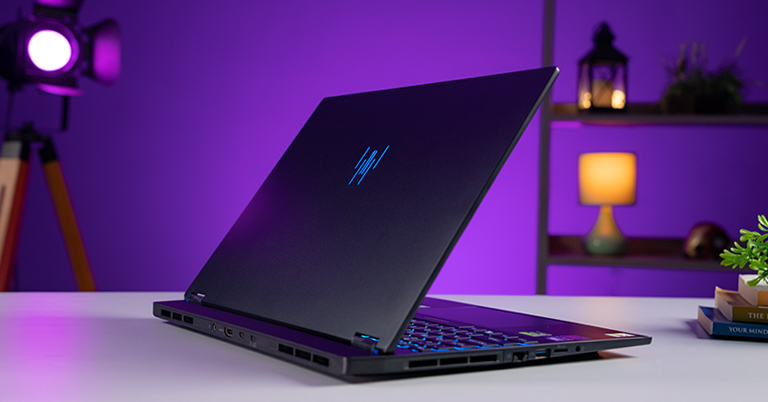The Acer Predator Helios Neo 16S AI is easily one of the best value-for-money laptops in its price range, offering a beautiful OLED display, a slim and professional-looking design, and powerful performance.
By
Published 22 hours ago

No headings found
Why Trust Gadgetbyte?
At Gadgetbyte, we invest substantial hours into rigorously testing each product or service we review, guaranteeing that you make informed purchases. Learn more about our testing process.
Review Overview
Design and build
8.5/10
Display
10/10
Keyboard
7/10
Performance
8.5/10
Audio
6.5/10
Webcam
7/10
Battery
6.5/10
Value for money
8.5/10
The all-new Acer Predator Helios Neo 16S AI (2025) has everything I could ask for, from a stunning OLED display with 100% DCI-P3 color coverage to the latest Intel and NVIDIA processors. That said, the Ultra 7 255HX with the RTX 5060 feels like a really solid deal compared to the Ultra 9 275HX with the RTX 5070.
Hello everyone! Today I have the all-new Acer Predator Helios Neo 16S AI, one of the most popular midrange gaming laptops. Now, don't get confused by the "S" - until last year, we only had the regular Neo 16. But this year, Acer introduced a new variant, the Neo 16S, where the "S" stands for "Slim."
So yeah, I've been using this beast for the past few days, and I am happy to say that it's been quite an enjoyable experience. I actually have two retail units with me, one with the Ultra 7 and RTX 5060, and the other with the Ultra 9 and RTX 5070.
Okay, before jumping to the review, let's see the specs first.
Acer Predator Helios Neo 16S AI (2025) Specifications:
- Dimensions: 275.5 × 356.78 × 18.97 mm
- Weight: 2.6 kg
- Display: 16” glossy OLED panel
- Display Properties: WQXGA resolution, 240Hz refresh rate, 100% DCI-P3 colours, 400 nits (typical) / 500 nits (peak)
- Keyboard: Full-size 24-zone RGB backlit keyboard
- Security: TPM 2.0, IR Face Unlock
- CPU:
- Intel Core Ultra 9 275HX (24 cores, 24 threads, up to 5.4 GHz)
- Intel Core Ultra 7 255HX (20 cores, 20 threads, up to 5.2 GHz)
- GPU:
- NVIDIA GeForce RTX 5070 (115W TGP, 8GB GDDR7 VRAM)
- NVIDIA GeForce RTX 5060 (115W TGP, 8GB GDDR7 VRAM)
- RAM: 16GB DDR-5 6400
- Storage: 1TB, 512 GB PCIe Gen 4 SSD
- Audio: Down-firing stereo speakers (2x 2W output)
- Battery: 76Wh Li-Ion Battery with 230W charging
- Webcam: FHD IR with support for Windows Hello Face Authentication
- Price in Nepal: Rs 284,999 (Ultra 9) / Rs. 252,999 (Ultra 7)
Acer Predator Helios Neo 16S AI (2025) Review:
What's inside the box?
Okay, before talking about the product itself, most people want to know what's included inside the box and what the unboxing experience is like.
Acer has kept the unboxing experience pretty simple, and we only get the essentials, such as the laptop itself, a few booklets, and a 230W round-pin charging brick—that's all.
Design and build
- Dimensions: 275.5 × 356.78 × 18.97 mm
- Weight: 2.6 kg
- Aluminium lid, plastic build
Okay, I'll start my review with the design part first. When I first unboxed this laptop, the first thing that really popped into my mind was just "Wow, it's really thin." The slim tag used on this laptop really makes sense and is not just a marketing gimmick.
I really loved the device's design language. It looks clean and professional, something that I can take anywhere. The matte black finish also gives it a premium look. At the back, we also get a cool Predator logo, which comes with RGB lighting. The only downside I noticed was that the lid attracts a lot—I mean a LOT—of fingerprint smudges when touched.
Speaking more about the build, we can open the lid with one hand, and the entire chassis feels sturdy and well-built, with no unusual flexing or creaking sounds. The rounded edges on every side also caught my attention. They made the overall experience more comfortable, mainly when using the laptop on the lap for longer periods. Also, the laptop comes with a curved front edge, which makes the typing experience more enjoyable.
Display
- 16-inch WQXGA OLED (2560 x 1600 pixels)
- 240Hz refresh rate, 100% DCI P3
- 400nits peak brightness
This display is easily one of the standout features of this laptop. We get a fast 240Hz OLED panel, while most laptops in this price segment still stick to 165Hz. It definitely feels smooth when scrolling, gaming, or navigating the UI. But honestly, coming from a 165Hz screen myself, the jump to 240Hz didn't feel like a massive upgrade.
As for colour coverage, as you can see in my test, this panel achieved 100% sRGB and 100% DCI-P3 coverage, and this is the best display you can get for this price. The colours are sharp and poppy, and they get bright enough, reaching 400 nits.
With all the positives, one drawback I noticed was that being an OLED panel, the screen gets quite reflective. With a window behind me, it sometimes became a bit difficult to see things clearly, and I had to increase the brightness, which started to strain my eyes after a while.
Keyboard and Trackpad
- 4-Zone RGB Keyboard
- Plastic trackpad with Windows Precision drivers

Shifting from a Lenovo TrueStrike keyboard to this was a little bit difficult for me, as the keys on the Acer are pretty close to each other, still being a 16-inch laptop. That said, after a couple of days, once I got used to it, the keyboard felt really good with a satisfying typing experience. Also, I love that Acer added a dedicated num pad.
But I am quite disappointed that it has 4-zone RGB lighting, which looks nice and has enough brightness, though I was kind of expecting per-key RGB or at least 24-zone RGB lighting. Acer is still reserving per-key for the more expensive "high-end" Predator laptops.
Okay, I want to talk about one more thing, which is the new Copilot key, which I'm not a fan of. The key has a pretty huge size and sits just beside the left arrow key. Clicking this key opens Windows Copilot, which I barely use, and there is no way to remap or disable it in the Predator Sens software.
That said, the keyboard feels pretty solid overall. The trackpad is big, smooth, and works fine for gestures and gliding.
Webcam, Speakers, and battery
- Speakers: Dual Stereo Speakers
- Webcam: FHD IR with support for Windows Hello Face Authentication
- 76 Wh battery with 230W charging
The speakers on this laptop are decent but not excellent. I played various songs in my office, and even my colleagues thought the volume was decent. That said, the sound is quite thin and lacks bass, so it doesn't feel full or punchy.
The webcam is fine for calls, though the image quality looks basic and pixelated. We also get cool Windows effects, such as blurring the background, portrait mode, eye contact features, and automatic framing.
This camera also supports Windows Hello features, which allow us to unlock the laptop with Face Unlock. The IR login usually works most of the time, but it can sometimes be slow, which can be really annoying.
Okay, so talking about the battery life, this is where things get a bit disappointing. I was only getting around 2 to 2.5 or max 3 hours of screen time doing everyday stuff like browsing the web, editing documents, and watching YouTube videos. So yeah, if you're planning to use this out without a charger, you'll definitely need to find a plug pretty soon!
Ports
As for the ports, I really like the port selection on this laptop.
- On the right: two USB 3.2 Gen 2 (10 Gbps) type-A ports.
- On the left: a fast Ethernet port (2.5 Gbps), one USB 3.2 Gen 2 (10 Gbps) Type-A port, a micro SD card, and a headphone mic combo.
- On the back: a barrel pin for charging, an HDMI 2.1, and two Thunderbolt 4 ports (both supporting charging, with one connected to the iGPU and the other to the dGPU).
I really like the port selection, but having a lot of ports on the side makes it difficult for me to manage cables on my desk.
Storage
As for storage, the Ultra 9 model features a 1TB Gen 4 SSD, whereas the lower-end Ultra 7 variant comes with a 512GB Gen 4 SSD. In terms of speed, both SSDs have very fast read and write speeds for everyday use, so yeah, no complaints here.
Performance
- Intel Core Ultra 9 275HX CPU + RTX 5070 GPU (115W)
- Intel Core Ultra 7 255HX CPU + RTX 5060 GPU (115W)
- 16GB DDR5 RAM
Okay, let's discuss the performance of these two laptops. This is the only part where you'll really notice a difference.
Note that: "All the tests are done on Turbo Mode with Fan profile set to Max"
CPU
Both devices come with Intel's Latest Series 2 "HX" processors. One features the Ultra 9 275HX with 24 cores and 24 threads, and the other the Ultra 7 255HX with 20 cores and 20 threads.
During regular office work, both laptops performed exceptionally well. Whether I was working with documents, hopping between tabs, or performing various tasks, everything felt really smooth. Now, regarding benchmarks, I only ran Cinebench 2024, where the results were as follows

Looking at the scores, the Ultra 9 is approximately 9.5% faster in multi-core and about 4% faster in single-core compared to the Ultra 7 255HX, which is not a huge jump.
RTX 5060 vs RTX 5070
Both the RTX 5060 and RTX 5070 come with just 8GB VRAM with the same 128-bit memory bus. However, the CUDA cores on the RTX 5070 are 4608 compared to those on the RTX 5060, which have only 3328.
Okay, for comparing the raw GPU strength, I ran the Fire Strike Extreme test and Time Spy.
Looking at the benchmark scores, the Ultra 9 variant performs about 5.5% faster than the Ultra 7 variant in 3DMark Time Spy. Similarly, in Fire Strike Extreme, the Ultra 9 variant comes out ahead by approximately 6.83% compared to the Ultra 7 variant.
Gaming
Okay, now it's time for the gaming review of these two laptops.
For a more detailed comparison, as we have already reviewed the Lenovo Legion Pro 5i (review), which also comes with the same CPU and GPU, I can provide a more detailed comparison of the 5070 variant.
The results from these games are pretty close overall, and getting this kind of performance from such a slim laptop really impressed me!
So, I played the exact games with the RTX 5060 on exact settings at 1600p resolution.
What I found is that in most games, the RTX 5070 with Ultra 9 275HX is roughly around 10-14% faster than the RTX 5060 with Ultra 7 255HX. But strangely, on Cyberpunk, the results were quite similar across multiple test runs.
During gaming, the temperature on the keyboard deck was also manageable. For the Ultra 9 variant, most of the time around the WASD keys, the temperature was around 35-39 degrees, maxing at 41.2 degrees while playing Cyberpunk on Ultra High settings, whereas on Ultra 7, the WASD keys hovered around 35-40 degrees.
One more thing..
As we know, the RTX 5060 and RTX 5070 come with just 8GB of VRAM, and while playing GPU-heavy games like Forza Horizon 5 and Cyberpunk 2077, I experienced significant frame drops that made my gaming experience worse. Forza even gave me a "Low video memory" warning when I was maxing out settings, and Cyberpunk had random crashes.
That said, the advantage of the newer NVIDIA 50-series card plays an important role here. NVIDIA's "Multi Frame Generation" technology provides a good FPS boost and makes a real difference in games. In Cyberpunk, the gaming experience feels really smooth despite the VRAM limitation. With both 2× and 4× Multi Frame Generation enabled, performance improvements are clearly seen as..
Conclusion
Okay, as we've reached the end of this review, I really loved this new Acer Predator Helios Neo 16S AI. It has everything I need, including a beautiful OLED display, a slim, professional design, powerful performance, and plenty of ports!
Saying that, we also have other options in this price range, like the Lenovo Legion Pro 5 2025 for NPR 244,999, which comes with AMD Ryzen 7 8745HX and RTX 5060 graphics. But here's the thing – we get a much faster CPU on the Acer, and the Legion also lacks that 240Hz fast refresh rate. So adding that extra NPR 8,000 for the Acer is absolutely worth it.
No Active Polls
There are currently no polls available. Check back later for new polls to participate in!
And at NPR 252,999, the Ultra 7 255HX with RTX 5060 makes way more sense and offers better value for money compared to the Ultra 9 275HX with RTX 5070. So the RTX 5060 configuration is definitely the sweet spot here, but if you need that extra raw power, you can always go with the RTX 5070 option.
Acer Predator Helios Neo 16S AI (2025) review: Pros and Cons
| Pros | Cons |
| • An excellent OLED display | • No 24-Zone or Per-Key RGB Keyboard |
| • powerful performance | • Mediocre trackpad, battery life |
| • Slim and professional design | • Attracts a lot of fingerprint smudges |
| • A satisfying keyboard with Numpad | |
| • Windows Hello IR Login |





